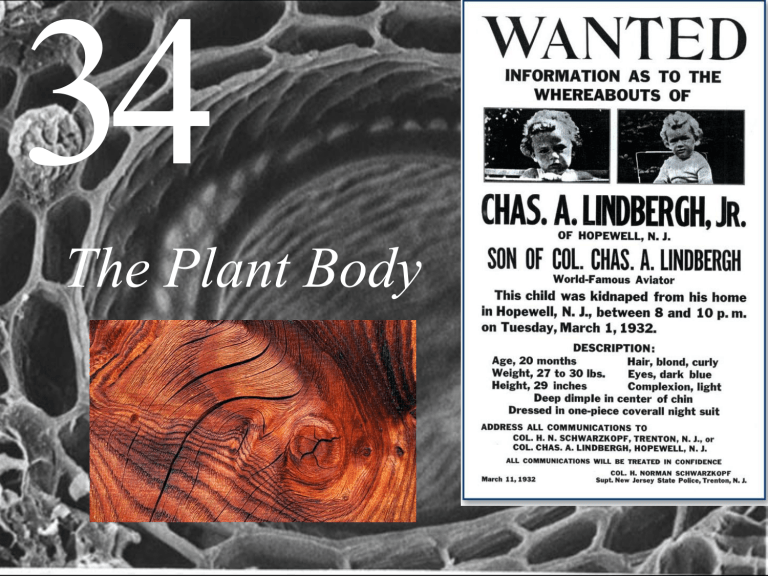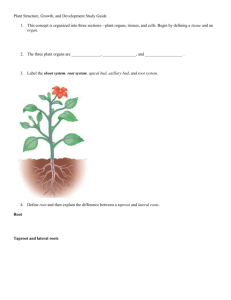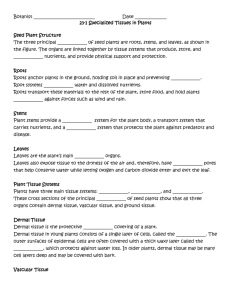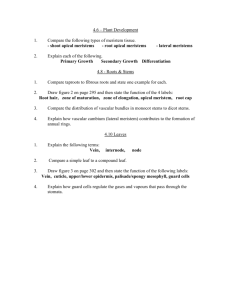LIFE Ch34_Lecture

34
The Plant Body
34 The Plant Body
• 34.1 How Is the Plant Body Organized?
• 34.2 How Are Plant Cells Unique?
• 34.3 How Do Meristems Build the Plant
Body?
• 34.4 How Does Leaf Anatomy Support
Photosynthesis?
34.1 RECAP:
• Monocots & Dicots
Basic body plan: root system & shoot system
Stems & leaves = part of shoot system
Bud = embryonic shoot
3 tissue systems: vascular, dermal, ground
97% of angiosperms are in 2 clades:
• Monocots : narrow-leaved; grasses, lilies, orchids, palms
• Eudicots : broad-leaved; soybeans, roses, sunflowers, maples
Remaining species have structure similar to eudicots: water lilies and magnoliids.
Figure 34.1 Monocots versus Eudicots
What’s an angiosperm?
vascular plants with: double fertilization, a triploid endosperm, seeds enclosed in modified leaves called carpels.
Three types of vegetative organs: roots, stems, leaves.
They are organized in two systems: shoot system and root system .
Figure 34.2 Vegetative Organs and Systems
Shoot system :
stems, leaves, flowers
(Leaves ...photosynthesis)
Stems hold and display leaves in the sun; connection between roots and leaves.
Nodes : points of attachment of leaf to stem. Regions in between are internodes .
Root system :
anchors plant & provides nutrition.
Extreme branching of roots provides large surface area for absorption of water and mineral nutrients.
Morphology vs. Anatomy?
Structure of vegetative organs, includes overall form.
Arrangement of component cells and tissues.
2 Types of Root Systems
Taproot systems : single, large, deepgrowing root and small side roots. The root may also function as food storage.
Fibrous root systems : many thin roots of equal diameter. Have large surface area; cling to soil well.
Adventitious roots :
arise above ground from stem or leaves.
Cutting: piece of shoot cut or broken from the plant. Adventitious roots may arise from cuttings, and can start a new plant — vegetative reproduction
(asexual).
Adventitious roots also help support many plants, such as corn.
Stems & Buds (Axillary, Apical)
elevate and support flowers and leaves; have buds or embryonic shoots.
Stems bear leaves at the nodes, buds in the angle or axil between shoot and leaf are axillary buds . Can develop into a branch.
Apical buds form at the tips —produce cells for upward growth; some may develop into flowers.
Stems can be modified:
Potato tuber is an underground stem.
Many desert plants have enlarged stems that store water.
Runners are horizontal stems, roots grow at intervals and independent plants can arise from them.
Figure 34.4 Modified Stems
Leaves: blade, petiole
Most photosynthesis occurs here.
The blade is a thin, flat organ attached to stem by the petiole .
Angle may be perpendicular to sun’s rays to provide maximum area for light gathering.
Some leaves change position during the day to track the sun.
Simple vs Compound Leaves
Simple leaves consist of a single blade.
Compound leaves have multiple blades or leaflets .
Figure 34.5 Simple and Compound Leaves
Leaves can be modified:
Some function as food storage, (e.g., onion bulbs). Leaves of succulents store water.
Cacti spines are modified leaves.
Climbing plants have modified leaves called tendrils that wrap around other structures.
What’s a Tissue ?
organized group of cells with similar structure and function.
Vascular, dermal, and ground tissue systems extend throughout the plant body in a concentric arrangement.
Figure 34.6 Three Tissue Systems Extend Throughout the Plant Body
The vascular tissue system :
the transport system
Xylem distributes water and minerals taken up by roots to all parts of the plant. Xylem can also function in storage and support.
Phloem transports carbohydrates from site of production ( sources ) to sites of utilization or storage ( sinks ).
The dermal tissue system :
the outer covering
The epidermis: single layer of cells or several layers. May contain specialized cells such as guard cells around stomata.
Shoot and leaf epidermis secretes waxy cuticle that retards water loss.
Stems and roots of woody plants have a periderm .
The ground tissue system
makes up the rest of the plant.
Functions in storage, support, photosynthesis, and production of defensive and attractive chemicals.
34.2 RECAP:
• Several types of plant cells
Different structures & functions
• Most only function when they’re alive
• SOME are specialized for support or transport & don’t function until they’re dead
34.2 How Are Plant Cells Unique?
• Have chloroplasts or other plastids.
• Contain vacuoles .
• Have cell walls with cellulose. Differ in composition depending on function of cell.
Some plant cells function after death when cell contents have disintegrated.
How’s cytokinesis different?
daughter cells are separated by the cell plate.
A glue-like material is deposited in the cell plate —the middle lamella .
Then the daughter cells secrete cellulose to form the primary wall .
Figure 34.7 Cell Wall Formation
Cell wall
outside the plasma membrane.
can contain proteins and enzymes.
Chemical reactions --cell expansion, defense.
Except where waterproofed, cell walls are permeable to water and mineral ions.
Plasmodesmata
connect adjacent plant cells.
Cytoplasm-filled canals, traversed by a strand of ER.
Can sometimes expand to allow macromolecules, including transcription factors and RNA, and viruses, to pass. Doesn’t require crossing a plasma membrane.
Figure 34.8 Plasmodesmata (Part 1)
Figure 34.8 Plasmodesmata (Part 2)
Parenchyma cells :
thin walls, large central vacuoles.
Photosynthetic cells in leaves are parenchyma cells with many chloroplasts.
Many store starch and lipids. Starch is often stored in leucoplasts .
Some parenchyma cells function in support.
Collenchyma cells :
thick primary cell walls, usually elongate shape.
Support in leaf petioles, non-woody stems, and growing organs.
Tissue with collenchyma cells is flexible.
Sclerenchyma cells :
thickened secondary walls. Many die after secondary wall is laid down.
Fibers : elongated cells provide rigid support; often in bundles.
Sclereids may be densely packed as in nut shells, or in clumps as in stone cells in pears.
Figure 34.9 Plant Cell Types (C, D)
Xylem
contains cells called tracheary elements — die before assuming their function.
Gymnosperms have tracheids with pits in the secondary walls that allow materials to move freely.
Vessel Elements
Angiosperms have vessel elements with pits.
Larger diameter than tracheids; lignin in secondary cell walls; end walls break down after death, forming hollow tubes.
Xylem of many angiosperms also contains tracheids.
Phloem transport cells —
sieve tube elements , are living.
Cells meet end-to-end; transport carbohydrates.
Plasmodesmata in end walls enlarge to form pores —form sieve plates .
Membrane that encloses central vacuole
( tonoplast ) disappears; nucleus and some cytoplasmic components break down, thus pores in sieve plate are not clogged.
Figure 34.10 Sieve Tubes
Sieve tube elements are filled with phloem sap — water, sugars, other solutes. Layer of cytoplasm stays at the periphery.
Each sieve tube element has one or more companion cells linked by plasmodesmata. Retain all organelles, they are the life-support system.
34.3 RECAP:
• Apical & lateral meristems
• Responsible for producing primary
& secondary plant bodies
• primary meristems: protoderm, ground meristem, procambium
• 2 lateral meristems: vascular cambium & cork cambium
Wood and bark arise from them
“Modules”
Growing stem, laid down 1 after another.
Each is a node w/ attached leaves, internode below, axillary buds at base of internode.
Each branch may be thought of as a separate module.
Branches form 1 after another may differ in # of leaves, & # of subsequent branches.
are long-lived.
Leaves are modules that are short-lived —weeks to a few years.
Root systems are also branching.
As root systems grow, roots may die and be replaced by new ones.
Plant Bodies
All plants have a primary plant body: all nonwoody parts of the plant.
Growth lengthens the plant body.
Monocots consist entirely of primary plant body!!!
Trees & shrubs have secondary plant body: wood and bark.
Tissues laid down as stems, roots thicken.
Grows throughout life of plant.
Meristems are...
localized regions of cell division.
Can produce new cells indefinitely.
Figure 34.11 Apical and Lateral Meristems (Part 1)
Figure 34.11 Apical and Lateral Meristems (Part 2)
Determinate & Indeterminate Growth
Some plant growth is determinate — leaves, flowers, fruits.
Growth of stems & roots is indeterminate — generated from specific regions of cell division and expansion.
Apical meristems
at tips of roots & stems, & in buds, give rise to the primary plant body.
give rise to a set of cylindrical primary meristems that produce the three tissue systems.
Shoot apical meristems extend stems & branches.
Root apical meristems extend roots.
The primary meristems:
protoderm , ground meristem , procambium
Lateral meristems
produce secondary growth:
• Vascular cambium :
• 2ary xylem (towards inside) --become wood;
• 2ary phloem (towards outside) --becomes bark
• Cork cambium : produces waxy-walled cork cells. Some of the cells become the bark.
• Wood = secondary xylem.
• Bark : everything external to vascular cambium (periderm plus secondary phloem).
A twig illustrates both primary & secondary growth.
Apical meristems are enclosed in buds.
Only the buds are entirely primary tissues.
Figure 34.12 A Woody Tree Twig Has Both Primary and Secondary Growth
As tree grows in diameter, outermost layers, including epidermis, dry & crack off.
Meristems may remain active for years, or centuries.
Oldest known living plant: a bristlecone pine, about 4,900 years-old!!!!!
Root apical meristem:
Some daughter cells become root cap — protects root tip as it grows through soil.
Detects gravity and controls downward growth of roots.
Center is quiescent center — few cell divisions. Can become active if needed.
Figure 34.14 Tissues and Regions of the Root Tip
Above quiescent center, daughter cells elongate to lengthen the root — zone of cell elongation .
Cells mature & differentiate in zone of maturation .
Many epidermal cells produce root hairs, which increase surface area for absorption.
Symbiotic Mycorrhizae :
Most plants have a fungus closely associated with the roots —
The fungus increases absorptive ability; many plants cannot survive without them!!!
Figure 34.15 Products of the Root’s Primary Meristems
STELE:
pericycle, xylem, and phloem.
Pericycle — undifferentiated cells:
• Gives rise to lateral roots & lateral meristems that thicken root
• Cells have transport proteins that move nutrient ions into the xylem.
Shoot apical meristem also forms three primary meristems that give rise to the three tissue systems.
Also lays down beginnings of leaves and axillary buds — leaf and bud primordia .
VASCULAR BUNDLES:
In young stems, vascular tissue is arranged in vascular bundles with both xylem and phloem.
Eudicots: vascular bundles form a cylinder.
Monocots: bundles are scattered.
Pith and cortex constitute the ground tissue system.
Stems may have storage tissue in center called the pith .
Cortex may also function as storage, and contain collenchyma cells.
Secondary growth
results from lateral meristems in eudicots.
Vascular cambium is initially a single layer of cells between primary xylem and phloem.
Division of these cells produces secondary phloem cells toward the outside, and secondary xylem cells toward the inside.
Figure 34.18 Vascular Cambium Thickens Stems and Roots
Figure 34.19 Vascular Rays and Vessel Elements
Monocots: Palms
Monocots that have thickened stems, such as palms, don’t have vascular or cork cambiums.
Palms have a wide apical meristem that produces a wide stem.
Dead leaf bases also contribute to the stem diameter.
Variation among tree trunks: Annual Rings
Tree trunks from temperate regions show annual rings: result from seasonal conditions.
• Spring: water is plentiful, tracheids or vessel elements produced have large diameter.
• Summer: less water, smaller diameter cells with thicker walls are produced.
As a tree grows in diameter, xylem in center can become clogged with waterinsoluble substances, and appear darker; the heartwood .
The xylem that actively conducts water is the sapwood .
Knots are cross sections of branches.
34.4 RECAP:
• LEAVES: organs of photosynthesis
• Exchange gases w/atmosphere
• Obtain water & nutrients from roots
• Export products of photosynthesis through phloem
How Does Leaf Anatomy Support Photosynthesis?
Leaf anatomy is adapted to carry out photosynthesis, & the exchange of O
2 environment, and CO
2 with the while limiting water losses.
Two zones of parenchyma cells make up the mesophyll :
Palisade mesophyll
• Spongy mesophyll
Also includes air space for diffusion of gases.
Figure 34.23 The Eudicot Leaf (A)
Vascular tissue forms veins in leaves.
Veins extend to within a few cell diameters of all cells, so mesophyll cells are well supplied with water & minerals, & products of photosynthesis can be conducted to phloem.
The epidermal cells are nonphotosynthetic:
& have a waxy cuticle impermeable to water.
prevents water loss, but also prevents diffusion of gases.
Pores: stomata allow gas exchange.
--opened & closed by guard cells .
Figure 34.23 The Eudicot Leaf (C)
C
4 plants have a modified leaf anatomy allows them to fix CO
2 at low levels.
The photosynthetic cells are grouped around veins forming an outer mesophyll and a bundle sheath.
CO
2 is first fixed in mesophyll cells, then moves to bundle sheath cells for photosynthesis.
Figure 8.17 Leaf Anatomy of C
3 and C
4
Plants









